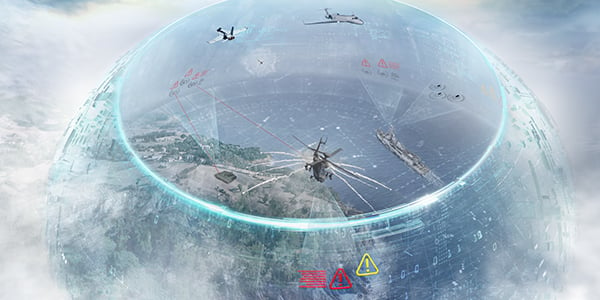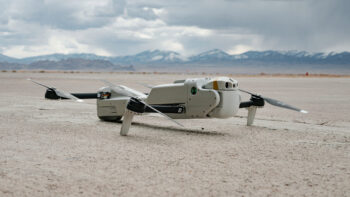
(image courtesy of BAE Systems)
What is BAE Systems’ Intrepid Shield™?
Intrepid Shield is our full-spectrum approach to platform survivability. Executing missions in the modern battlespace is extremely challenging; platforms will be seen and will be engaged. Our platforms need a coordinated, complimentary approach to survivability to penetrate and survive, using the full electromagnetic spectrum to detect, exploit, and counter advanced threats. We call this concept Intrepid Shield.
Tell us about the threat.
The modern battlespace is getting more and more complex every day and surviving is harder than ever in the air, sea, space, and ground domains.
A platform executing a mission in a modern, heavily contested battlespace will be met with coordinated threat sensors and weapons that will observe and engage the platform throughout its mission. Emerging threats from the ground, sea, air, or space are extending the contested area well beyond the horizon, holding previously safe assets at risk.
Any penetrating platform will have to deal with layered long-, medium-, and short-range air defenses from the sea, air, or ground. That includes long-range early warning from aircraft, ground- and maritime-based radars, and increasingly, unmanned systems. That’s followed by fighters with advanced air-to-air missiles, highly sophisticated surface-to-air missile systems, all the way down to short-range man-portable air defense systems (MANPADS) and small arms fire. All of these weapon systems are supported by electronic warfare systems denying our communications and sensors, and by networks of sensors on robust command-and control networks that pass fused data around the battlespace. On any given mission, you may encounter all of these threats and must survive.
Can you explain what you mean by full-spectrum electromagnetic warfare?
The different threat systems use different parts of the electromagnetic spectrum to accomplish their missions. There are two bands of the electromagnetic spectrum that are primarily used in electromagnetic warfare – radio frequency (RF) and electro-optical/infrared (EO/IR) – and each has different properties. In the most general terms, RF sensors detect RF energy reflected or emitted from the target and EO/IR sensors detect reflected or emitted light and heat from the target.
Airborne, ground, and maritime early warning, target acquisition, and engagement radars; missile seekers; radar jammers; and communications systems all operate in the RF spectrum. Different parts of the RF spectrum are used for different tasks. The accuracy and type of information needed, such as target velocity, position, or even shape, dictates the frequency band and waveform designs chosen for the radar system. RF is attractive because it can easily pass through the atmosphere, including poor atmospheric conditions like clouds and rain. However, active radar systems work by emitting energy, which makes them observable in the battlespace. Radars and RF communication systems are the primary transmitters on the modern battlefield, and the signal environment is incredibly dense. Deciphering who’s who, who sees me, and what I need to do about it is a really hard problem.
EO/IR sensors include everything from our eyeballs through large format, artificial intelligence- supported infrared cameras. That includes surveillance sensors, fire control sensors, and infrared missile seekers. Every platform in the battlespace has a detectable EO/IR signature, from hot engines and rocket motor plumes to reflected moonlight, all you need is a sensor in the right wavelength band. EO/IR energy doesn’t pass through the atmosphere very well, which traditionally restricted EO/IR sensors to shorter range tasks, but advances in sensor technology has greatly increased the range of EO/IR sensors in recent years. The advantage to EO/IR is that unlike active radar, sensors don’t have to emit energy, or rely on someone else deliberately emitting energy, to detect a target. This reduces the target’s awareness that it is being engaged, reducing the risk to the sensor platform.
The key enabler to full-spectrum RF and EO/IR kill chains is the network. In today’s battlespace, both RF and EO/IR sensors can and will communicate. Full spectrum electronic warfare means we must counter coordinated, full-spectrum threats that combine RF and EO/IR sensor data within the integrated air defense network, on ships and aircraft, and within missiles.
How do we break the kill chain?
Full-spectrum threat systems support the adversary’s kill chain – its method of finding and fixing, tracking and targeting, and engaging targets (see Illustration 1). BAE Systems’ Countermeasure and Electromagnetic Attack business develops systems to disrupt tracking and launch, detect and track missiles after launch, and jam or confuse guidance systems in the end game to defeat intercept.

Illustration 1 (courtesy of BAE Systems)
With kill chains loaded with networked sensors throughout the battlespace, survivability requires a full spectrum solution to break chains in all domains. Countermeasures must cover the whole spectrum, matching the band, power, and waveforms used by the threat – during acquisition and track, missile launch, midcourse guidance, and seeker handoff. With every threat evolution we must include more capability in our EW systems and sensors.
At the same time, EW systems and sensors need to be small, lightweight, energy-efficient, and cost effective to make it onto the platforms. They need to be powerful and sensitive, take advantage of advanced machine learning and artificial intelligence algorithms to improve performance and response speed, and be part of an open architecture to enable interoperability.
BAE Systems invests heavily in creating the smallest form factor, most efficient, smartest EW systems to make sure we defeat the threat and meet platform needs. We have also deeply invested in operational and threat analysis, performance modeling, algorithm development, and the digital engineering ecosystem, and are transforming our operational analysis capabilities in 2024 and beyond to ensure the technology is relevant for today’s and tomorrow’s fight.
There are many elements that go into survivability: solutions that enable freedom of maneuver, counter threats, and react faster than threats. These requirements drive the technology we develop. BAE Systems’ Countermeasure and Electromagnetic Attack Solutions (CEMA) business is at the forefront of electromagnetic warfare and missile warning, delivering a full-spectrum Intrepid Shield that breaks kill chains and ensures mission success.





















